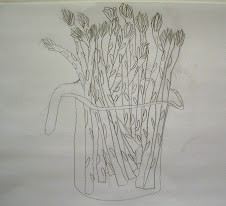
Back sometime in 1965 painter Andrew Wyeth was interviewed by Richard Meryman, an interview that was first published in Life magazine (May 14, 1965) and later reprinted in an exhibition catalog [The Art of Andrew Wyeth, ed. Wanda M. Corn]. In that interview, Wyeth is quoted making this prescient remark: "I came at the right moment in American art. I was alone. Now there are a lot of realists coming along -- I think partly because they've seen my success, to be perfectly honest -- but I think today the abstractionists are the conservatives and I'm the modernist." He elaborates upon the conservatism of modern art this way: "Everything is screaming with exaggeration today. I think artists today are caricaturing the truth, and life to me is more serious than that .... The abstractionists obliterate the object because it's a way of escaping perfunctory picturesquesness."
His remarks are prescient in their recognition of the growing exaggeration characteristic of big-ticket, acclaimed, art-world art and its effect upon its audience -- of the ways that its cognicenti gradually lose their sensitivity to nuance, order and texture of more comtemplative forms of art like realism. Realism did get a boost from Wyeth's success also, as he noted, though this phenomenon is less obvious to the casual gallery goer. Certain the museums have stuck close to the conservatism of abstraction and the isms that followed it. You do not see realist paintings in contemporary museums unless they come with the other requisites of modern art, such as violence, banality, shock value, politics or various other forms of "exaggeration." But many kinds of realist painting have been practiced during the decades since World War II, and various kinds of non-realist, painterly representational painting (such as Richard Diebenkorn's) also.
Why would anybody want to escape from "perfunctory picturesquesness"? Because to really explore the visual world in a serious way hasn't got anything to do with the obvertly "pretty." Nontheless, painting a picture that is both "pretty" and real -- well, perhaps that's the biggest challenge of all. Wyeth wasn't against the picturesque, he just wanted something more than that as have innumerable artists before him. But it is just this fact that painting "real life" is very difficult, to escape from convention and to just paint, takes skill and insight. Some artists took the easy way by eliminating subject matter from the mix, but then it's the "abstraction" itself that becomes picturesque and pretty.
Real painting is difficult, but it's worth pursuing anyway. Even failing at the real thing has its benefits for it really is nobel to aim at a nobel goal.
[top: Andrew Wyeth's "Pageboy" republished from http://www.gbcnv.edu/~techdesk/AngelaConrad/Helga.html]

1 comment:
Hey Muse; Happy summer. I like Wyeth, I have his "Master Bedroom" in my bedroom. I've been to the Brandywine Museum here in my neck 'O da woods many times. Like all the other stuff here too!
HeevenSteven
Post a Comment